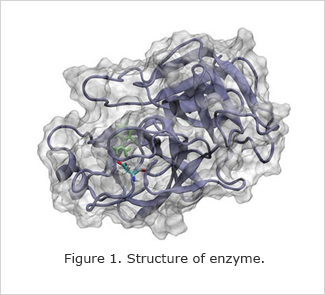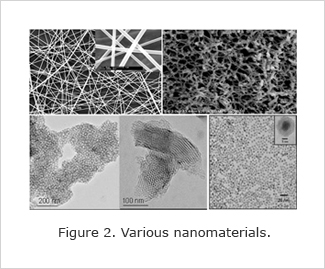Nanobiocatalysis
In spite of their merits in industrial fields, enzymes are restricted their usefulness due to the denaturation of enzyme structure and short lifespan of enzymes caused by their instability.
There have been a lot of attempts to solve instability of enzymes by using various technologies such as enzyme immobilization, chemical mutation of enzymes, protein engineering, gene manipulation,and solvent engineering.
Those stabilization approaches have seems to achieve improved stability when compared to free enzyme, but it was not sufficient level to apply stabilized enzymes to real industrial applications.
Recent remarkable developments offer the solutions of enzyme stabilization issues.
Nanomaterials that include nanoporous materials, nanofibers, nanoparticles, nanotubes have ideal properties to enzyme immobilization and they provide large surface to volume ratio that makes much more enzyme loading compared to convention carriers used in enzyme immobilization. Recently published research results that represent the synergetic interactions of enzyme immobilization with nanomaterials have opened a new prospect in the field of “Nanobiocatalysis”.
In the light of above information, it is prospected the possibility to solve the instability of free enzymes that is pointed out as the serious problem. Through stabilization of enzyme, the potential usefulness of enzymes is expected to dramatically increase.

- Enzymes are eco-friendly biocatalysts that catalyze chemical reactions of living organisms. Because of their unique substrate specificity and very fast reaction rate, they attract attentions of many researchers and are estimated as potentially useful in the catalytic reaction fields.
Furthermore, they attain biological activity at moderate operational conditions and produce little byproduct. Due to these reasons, enzymes are highly valuable in the industrial fields and already they are currently used for wide range of industrial sectors.
Enzyme have vital role in biotechnological industries such as, pharmaceutics, fine chemistry, food industry,
In spite of their merits in industrial fields, enzymes are restricted their usefulness due to the denaturation of enzyme structure and short lifespan of enzymes caused by their instability.
There have been a lot of attempts to solve instability of enzymes by using various technologies such as enzyme immobilization, chemical mutation of enzymes, protein engineering, gene manipulation,and solvent engineering.
Those stabilization approaches have seems to achieve improved stability when compared to free enzyme, but it was not sufficient level to apply stabilized enzymes to real industrial applications.
Recent remarkable developments offer the solutions of enzyme stabilization issues.
Nanomaterials that include nanoporous materials, nanofibers, nanoparticles, nanotubes have ideal properties to enzyme immobilization and they provide large surface to volume ratio that makes much more enzyme loading compared to convention carriers used in enzyme immobilization. Recently published research results that represent the synergetic interactions of enzyme immobilization with nanomaterials have opened a new prospect in the field of “Nanobiocatalysis”.
- Nanobiocatalysis laboratory has three original base platforms, enzyme coating, nanoscale enzyme reactor, and single enzyme nanoparticles which are the results of the convergence of nanotechnologies and enzyme technologies.
Based on these platforms, nanobiocatalysis laboratory looking for breakthorough in enzyme stabilization and immobilization experiments in nanobiocatalysis fields.
Enzyme stabilization and immobilization technologies by using nanobiocatalysis approaches show remarkable stabilization results that cannot be achieved by conventional stabilization technologies. 
In the light of above information, it is prospected the possibility to solve the instability of free enzymes that is pointed out as the serious problem. Through stabilization of enzyme, the potential usefulness of enzymes is expected to dramatically increase.


